Financial Analysis and Investment Appraisal Techniques for Proposed Project
VerifiedAdded on 2023/06/12
|10
|1752
|461
AI Summary
This article provides a financial analysis and investment appraisal techniques for a proposed project. It includes calculating the spreadsheet financial analysis of the proposed project and conducting a memo to Pinto’s CEO explaining and justifying the recommendation for the proposed project.
Contribute Materials
Your contribution can guide someone’s learning journey. Share your
documents today.

Running head: FINANCE
Finance
Name of the Student:
Name of the University:
Authors Note:
Finance
Name of the Student:
Name of the University:
Authors Note:
Secure Best Marks with AI Grader
Need help grading? Try our AI Grader for instant feedback on your assignments.
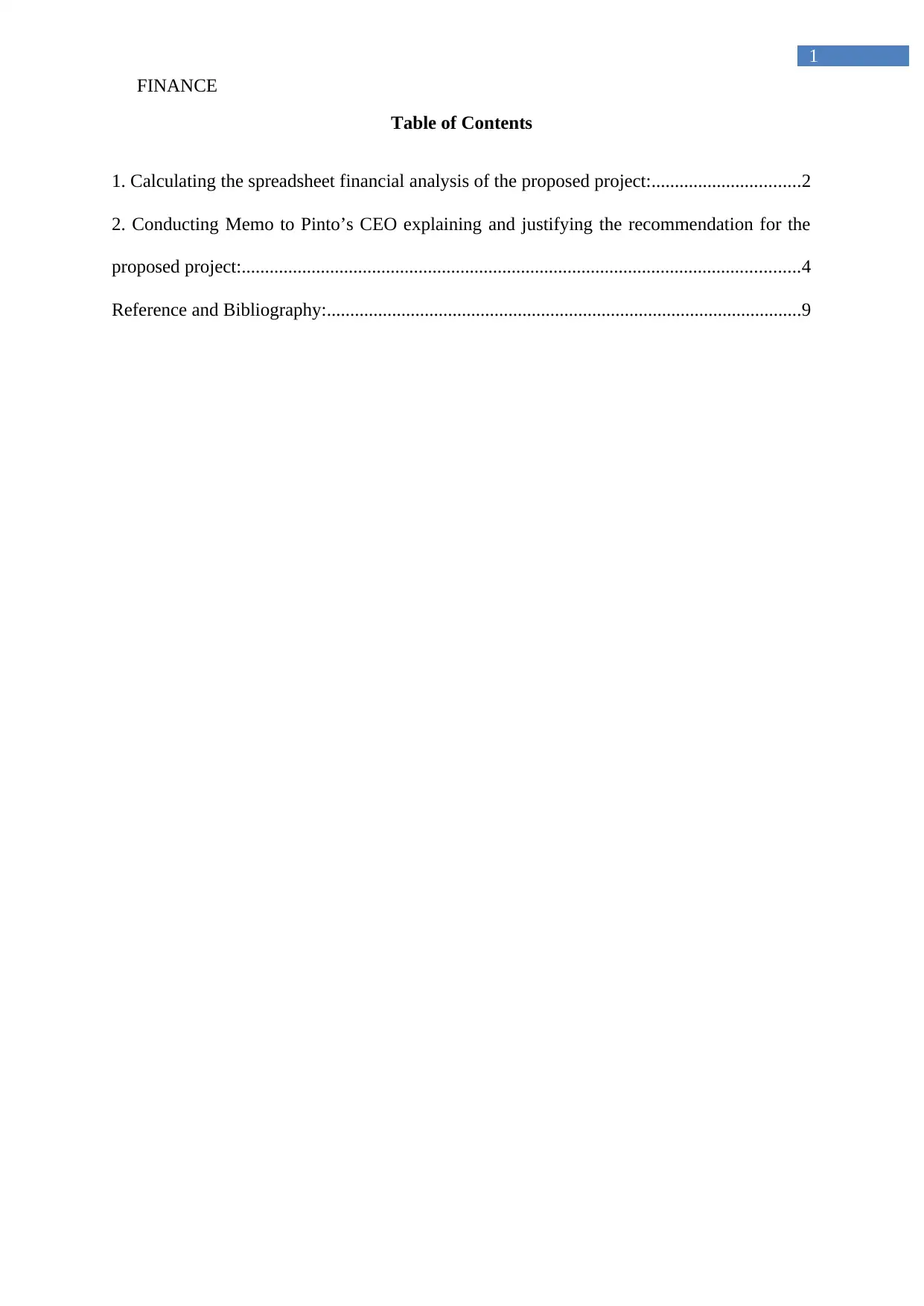
FINANCE
1
Table of Contents
1. Calculating the spreadsheet financial analysis of the proposed project:................................2
2. Conducting Memo to Pinto’s CEO explaining and justifying the recommendation for the
proposed project:........................................................................................................................4
Reference and Bibliography:......................................................................................................9
1
Table of Contents
1. Calculating the spreadsheet financial analysis of the proposed project:................................2
2. Conducting Memo to Pinto’s CEO explaining and justifying the recommendation for the
proposed project:........................................................................................................................4
Reference and Bibliography:......................................................................................................9
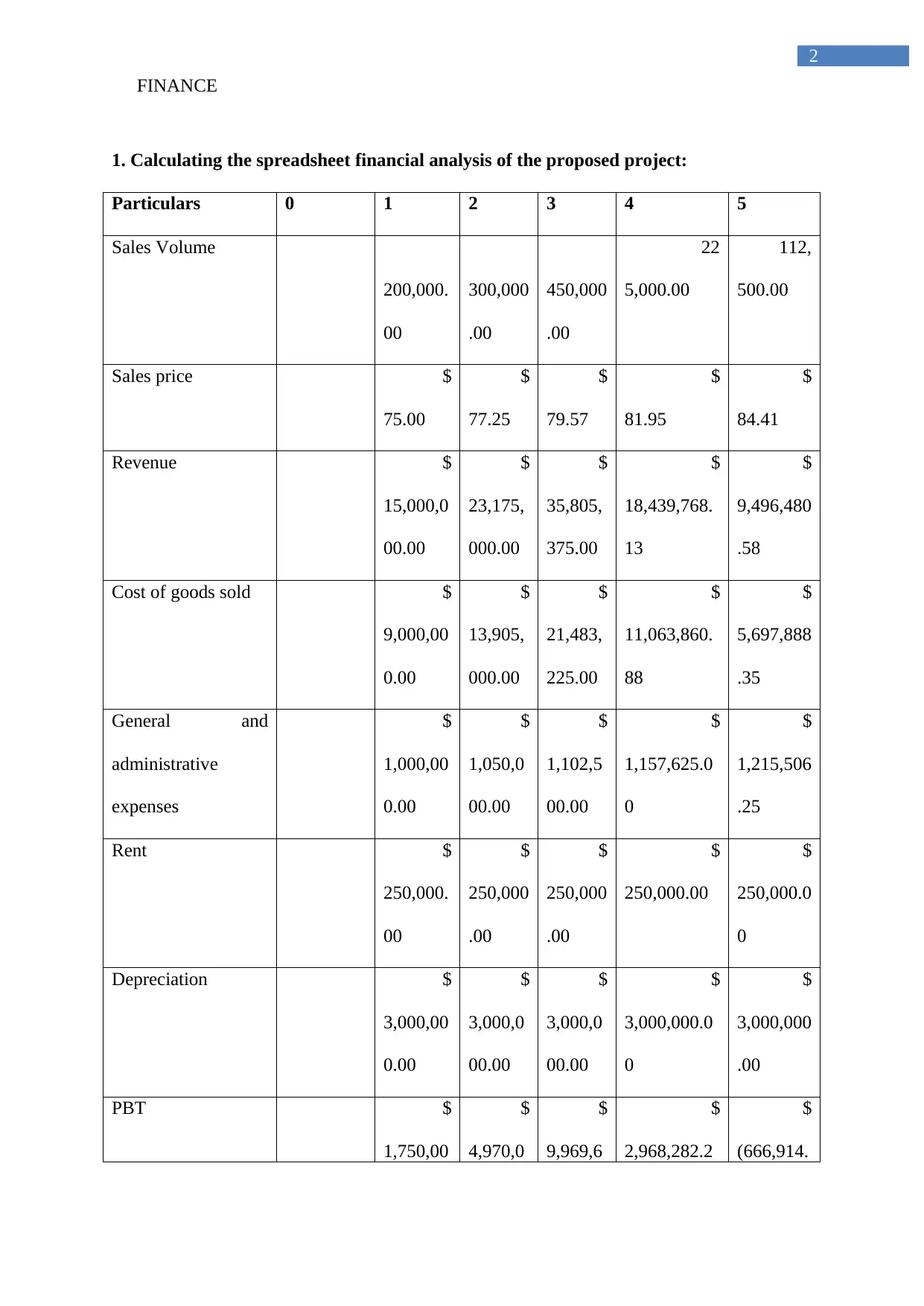
FINANCE
2
1. Calculating the spreadsheet financial analysis of the proposed project:
Particulars 0 1 2 3 4 5
Sales Volume
200,000.
00
300,000
.00
450,000
.00
22
5,000.00
112,
500.00
Sales price $
75.00
$
77.25
$
79.57
$
81.95
$
84.41
Revenue $
15,000,0
00.00
$
23,175,
000.00
$
35,805,
375.00
$
18,439,768.
13
$
9,496,480
.58
Cost of goods sold $
9,000,00
0.00
$
13,905,
000.00
$
21,483,
225.00
$
11,063,860.
88
$
5,697,888
.35
General and
administrative
expenses
$
1,000,00
0.00
$
1,050,0
00.00
$
1,102,5
00.00
$
1,157,625.0
0
$
1,215,506
.25
Rent $
250,000.
00
$
250,000
.00
$
250,000
.00
$
250,000.00
$
250,000.0
0
Depreciation $
3,000,00
0.00
$
3,000,0
00.00
$
3,000,0
00.00
$
3,000,000.0
0
$
3,000,000
.00
PBT $
1,750,00
$
4,970,0
$
9,969,6
$
2,968,282.2
$
(666,914.
2
1. Calculating the spreadsheet financial analysis of the proposed project:
Particulars 0 1 2 3 4 5
Sales Volume
200,000.
00
300,000
.00
450,000
.00
22
5,000.00
112,
500.00
Sales price $
75.00
$
77.25
$
79.57
$
81.95
$
84.41
Revenue $
15,000,0
00.00
$
23,175,
000.00
$
35,805,
375.00
$
18,439,768.
13
$
9,496,480
.58
Cost of goods sold $
9,000,00
0.00
$
13,905,
000.00
$
21,483,
225.00
$
11,063,860.
88
$
5,697,888
.35
General and
administrative
expenses
$
1,000,00
0.00
$
1,050,0
00.00
$
1,102,5
00.00
$
1,157,625.0
0
$
1,215,506
.25
Rent $
250,000.
00
$
250,000
.00
$
250,000
.00
$
250,000.00
$
250,000.0
0
Depreciation $
3,000,00
0.00
$
3,000,0
00.00
$
3,000,0
00.00
$
3,000,000.0
0
$
3,000,000
.00
PBT $
1,750,00
$
4,970,0
$
9,969,6
$
2,968,282.2
$
(666,914.
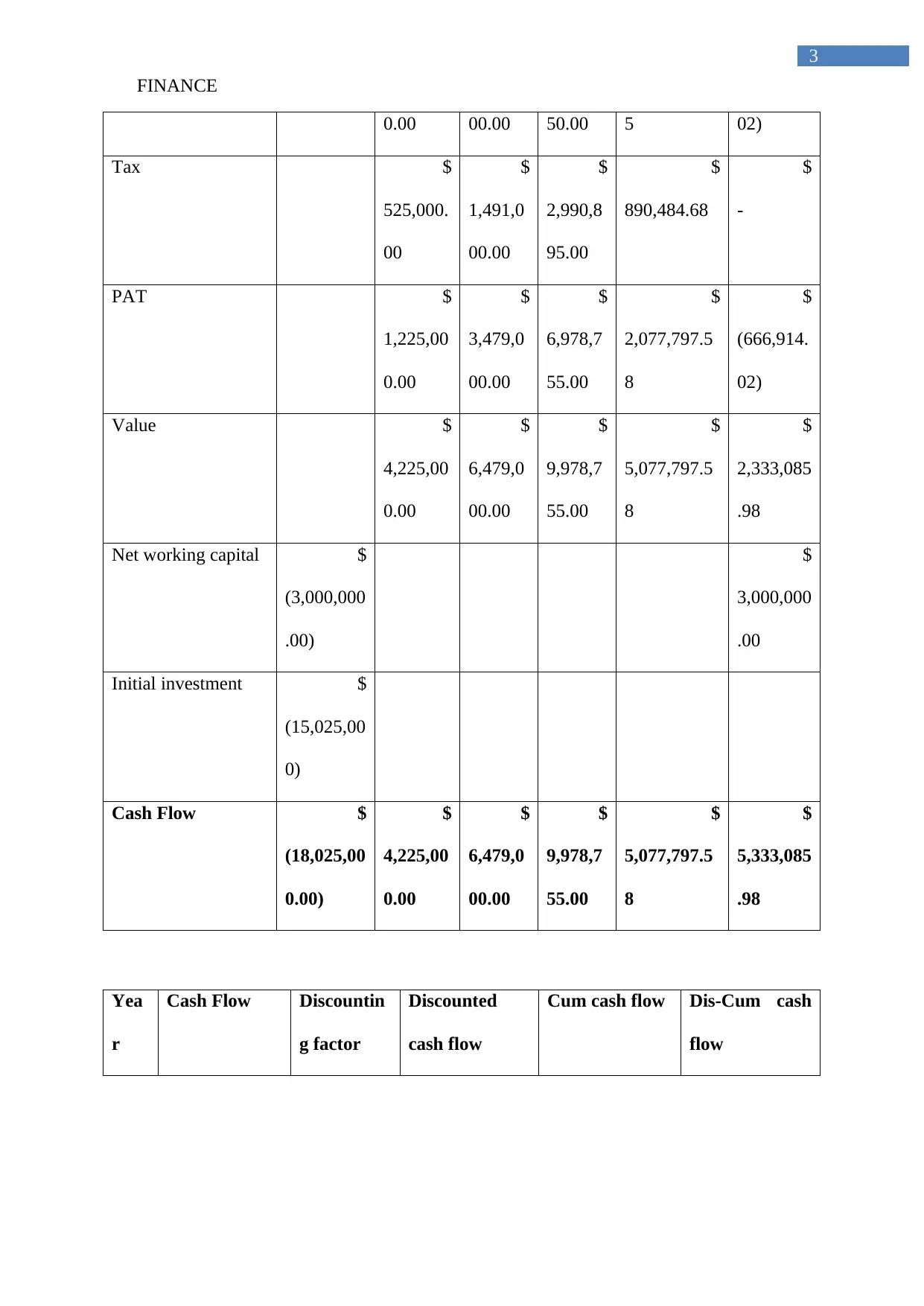
FINANCE
3
0.00 00.00 50.00 5 02)
Tax $
525,000.
00
$
1,491,0
00.00
$
2,990,8
95.00
$
890,484.68
$
-
PAT $
1,225,00
0.00
$
3,479,0
00.00
$
6,978,7
55.00
$
2,077,797.5
8
$
(666,914.
02)
Value $
4,225,00
0.00
$
6,479,0
00.00
$
9,978,7
55.00
$
5,077,797.5
8
$
2,333,085
.98
Net working capital $
(3,000,000
.00)
$
3,000,000
.00
Initial investment $
(15,025,00
0)
Cash Flow $
(18,025,00
0.00)
$
4,225,00
0.00
$
6,479,0
00.00
$
9,978,7
55.00
$
5,077,797.5
8
$
5,333,085
.98
Yea
r
Cash Flow Discountin
g factor
Discounted
cash flow
Cum cash flow Dis-Cum cash
flow
3
0.00 00.00 50.00 5 02)
Tax $
525,000.
00
$
1,491,0
00.00
$
2,990,8
95.00
$
890,484.68
$
-
PAT $
1,225,00
0.00
$
3,479,0
00.00
$
6,978,7
55.00
$
2,077,797.5
8
$
(666,914.
02)
Value $
4,225,00
0.00
$
6,479,0
00.00
$
9,978,7
55.00
$
5,077,797.5
8
$
2,333,085
.98
Net working capital $
(3,000,000
.00)
$
3,000,000
.00
Initial investment $
(15,025,00
0)
Cash Flow $
(18,025,00
0.00)
$
4,225,00
0.00
$
6,479,0
00.00
$
9,978,7
55.00
$
5,077,797.5
8
$
5,333,085
.98
Yea
r
Cash Flow Discountin
g factor
Discounted
cash flow
Cum cash flow Dis-Cum cash
flow
Secure Best Marks with AI Grader
Need help grading? Try our AI Grader for instant feedback on your assignments.
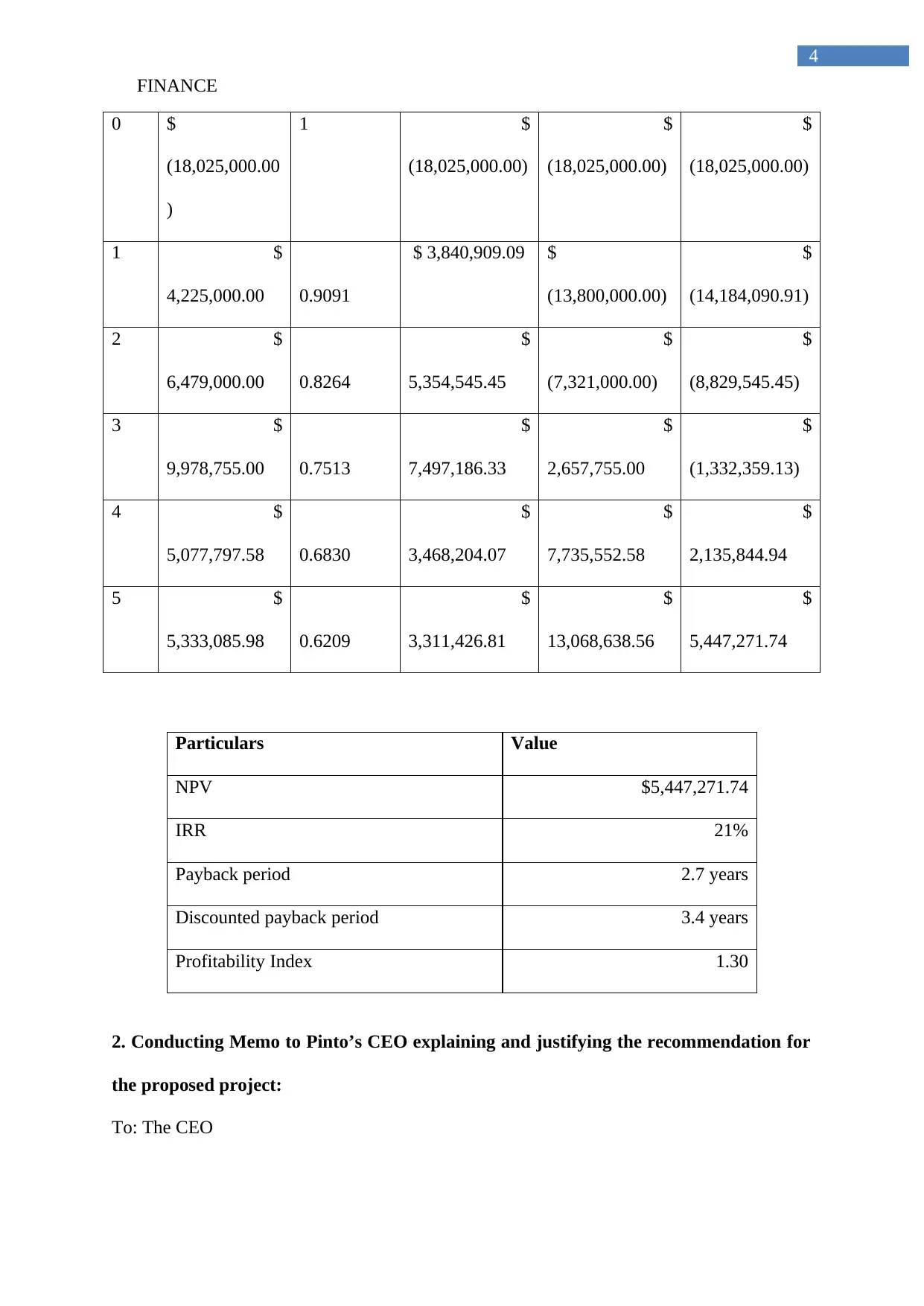
FINANCE
4
0 $
(18,025,000.00
)
1 $
(18,025,000.00)
$
(18,025,000.00)
$
(18,025,000.00)
1 $
4,225,000.00 0.9091
$ 3,840,909.09 $
(13,800,000.00)
$
(14,184,090.91)
2 $
6,479,000.00 0.8264
$
5,354,545.45
$
(7,321,000.00)
$
(8,829,545.45)
3 $
9,978,755.00 0.7513
$
7,497,186.33
$
2,657,755.00
$
(1,332,359.13)
4 $
5,077,797.58 0.6830
$
3,468,204.07
$
7,735,552.58
$
2,135,844.94
5 $
5,333,085.98 0.6209
$
3,311,426.81
$
13,068,638.56
$
5,447,271.74
Particulars Value
NPV $5,447,271.74
IRR 21%
Payback period 2.7 years
Discounted payback period 3.4 years
Profitability Index 1.30
2. Conducting Memo to Pinto’s CEO explaining and justifying the recommendation for
the proposed project:
To: The CEO
4
0 $
(18,025,000.00
)
1 $
(18,025,000.00)
$
(18,025,000.00)
$
(18,025,000.00)
1 $
4,225,000.00 0.9091
$ 3,840,909.09 $
(13,800,000.00)
$
(14,184,090.91)
2 $
6,479,000.00 0.8264
$
5,354,545.45
$
(7,321,000.00)
$
(8,829,545.45)
3 $
9,978,755.00 0.7513
$
7,497,186.33
$
2,657,755.00
$
(1,332,359.13)
4 $
5,077,797.58 0.6830
$
3,468,204.07
$
7,735,552.58
$
2,135,844.94
5 $
5,333,085.98 0.6209
$
3,311,426.81
$
13,068,638.56
$
5,447,271.74
Particulars Value
NPV $5,447,271.74
IRR 21%
Payback period 2.7 years
Discounted payback period 3.4 years
Profitability Index 1.30
2. Conducting Memo to Pinto’s CEO explaining and justifying the recommendation for
the proposed project:
To: The CEO
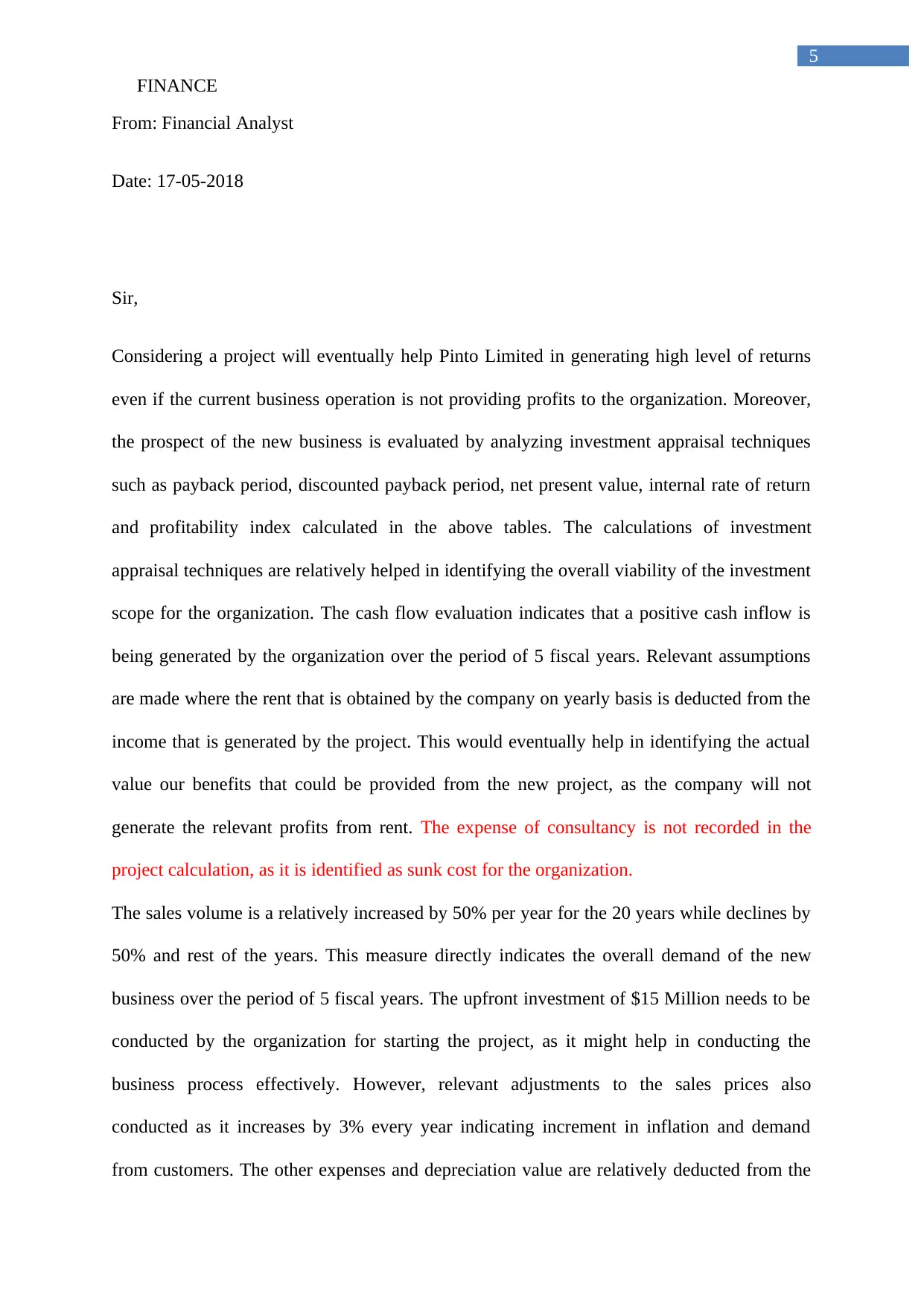
FINANCE
5
From: Financial Analyst
Date: 17-05-2018
Sir,
Considering a project will eventually help Pinto Limited in generating high level of returns
even if the current business operation is not providing profits to the organization. Moreover,
the prospect of the new business is evaluated by analyzing investment appraisal techniques
such as payback period, discounted payback period, net present value, internal rate of return
and profitability index calculated in the above tables. The calculations of investment
appraisal techniques are relatively helped in identifying the overall viability of the investment
scope for the organization. The cash flow evaluation indicates that a positive cash inflow is
being generated by the organization over the period of 5 fiscal years. Relevant assumptions
are made where the rent that is obtained by the company on yearly basis is deducted from the
income that is generated by the project. This would eventually help in identifying the actual
value our benefits that could be provided from the new project, as the company will not
generate the relevant profits from rent. The expense of consultancy is not recorded in the
project calculation, as it is identified as sunk cost for the organization.
The sales volume is a relatively increased by 50% per year for the 20 years while declines by
50% and rest of the years. This measure directly indicates the overall demand of the new
business over the period of 5 fiscal years. The upfront investment of $15 Million needs to be
conducted by the organization for starting the project, as it might help in conducting the
business process effectively. However, relevant adjustments to the sales prices also
conducted as it increases by 3% every year indicating increment in inflation and demand
from customers. The other expenses and depreciation value are relatively deducted from the
5
From: Financial Analyst
Date: 17-05-2018
Sir,
Considering a project will eventually help Pinto Limited in generating high level of returns
even if the current business operation is not providing profits to the organization. Moreover,
the prospect of the new business is evaluated by analyzing investment appraisal techniques
such as payback period, discounted payback period, net present value, internal rate of return
and profitability index calculated in the above tables. The calculations of investment
appraisal techniques are relatively helped in identifying the overall viability of the investment
scope for the organization. The cash flow evaluation indicates that a positive cash inflow is
being generated by the organization over the period of 5 fiscal years. Relevant assumptions
are made where the rent that is obtained by the company on yearly basis is deducted from the
income that is generated by the project. This would eventually help in identifying the actual
value our benefits that could be provided from the new project, as the company will not
generate the relevant profits from rent. The expense of consultancy is not recorded in the
project calculation, as it is identified as sunk cost for the organization.
The sales volume is a relatively increased by 50% per year for the 20 years while declines by
50% and rest of the years. This measure directly indicates the overall demand of the new
business over the period of 5 fiscal years. The upfront investment of $15 Million needs to be
conducted by the organization for starting the project, as it might help in conducting the
business process effectively. However, relevant adjustments to the sales prices also
conducted as it increases by 3% every year indicating increment in inflation and demand
from customers. The other expenses and depreciation value are relatively deducted from the
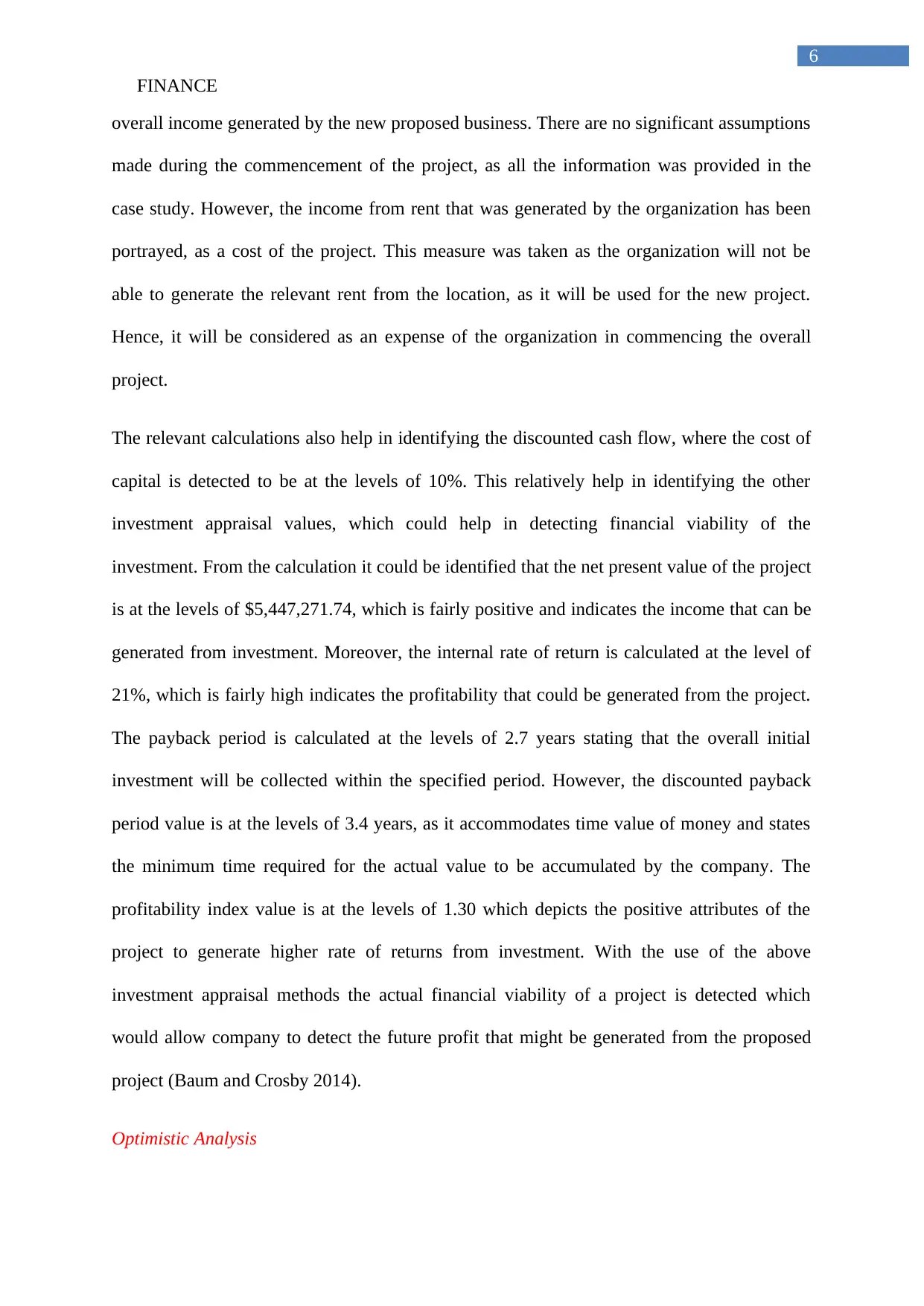
FINANCE
6
overall income generated by the new proposed business. There are no significant assumptions
made during the commencement of the project, as all the information was provided in the
case study. However, the income from rent that was generated by the organization has been
portrayed, as a cost of the project. This measure was taken as the organization will not be
able to generate the relevant rent from the location, as it will be used for the new project.
Hence, it will be considered as an expense of the organization in commencing the overall
project.
The relevant calculations also help in identifying the discounted cash flow, where the cost of
capital is detected to be at the levels of 10%. This relatively help in identifying the other
investment appraisal values, which could help in detecting financial viability of the
investment. From the calculation it could be identified that the net present value of the project
is at the levels of $5,447,271.74, which is fairly positive and indicates the income that can be
generated from investment. Moreover, the internal rate of return is calculated at the level of
21%, which is fairly high indicates the profitability that could be generated from the project.
The payback period is calculated at the levels of 2.7 years stating that the overall initial
investment will be collected within the specified period. However, the discounted payback
period value is at the levels of 3.4 years, as it accommodates time value of money and states
the minimum time required for the actual value to be accumulated by the company. The
profitability index value is at the levels of 1.30 which depicts the positive attributes of the
project to generate higher rate of returns from investment. With the use of the above
investment appraisal methods the actual financial viability of a project is detected which
would allow company to detect the future profit that might be generated from the proposed
project (Baum and Crosby 2014).
Optimistic Analysis
6
overall income generated by the new proposed business. There are no significant assumptions
made during the commencement of the project, as all the information was provided in the
case study. However, the income from rent that was generated by the organization has been
portrayed, as a cost of the project. This measure was taken as the organization will not be
able to generate the relevant rent from the location, as it will be used for the new project.
Hence, it will be considered as an expense of the organization in commencing the overall
project.
The relevant calculations also help in identifying the discounted cash flow, where the cost of
capital is detected to be at the levels of 10%. This relatively help in identifying the other
investment appraisal values, which could help in detecting financial viability of the
investment. From the calculation it could be identified that the net present value of the project
is at the levels of $5,447,271.74, which is fairly positive and indicates the income that can be
generated from investment. Moreover, the internal rate of return is calculated at the level of
21%, which is fairly high indicates the profitability that could be generated from the project.
The payback period is calculated at the levels of 2.7 years stating that the overall initial
investment will be collected within the specified period. However, the discounted payback
period value is at the levels of 3.4 years, as it accommodates time value of money and states
the minimum time required for the actual value to be accumulated by the company. The
profitability index value is at the levels of 1.30 which depicts the positive attributes of the
project to generate higher rate of returns from investment. With the use of the above
investment appraisal methods the actual financial viability of a project is detected which
would allow company to detect the future profit that might be generated from the proposed
project (Baum and Crosby 2014).
Optimistic Analysis
Paraphrase This Document
Need a fresh take? Get an instant paraphrase of this document with our AI Paraphraser
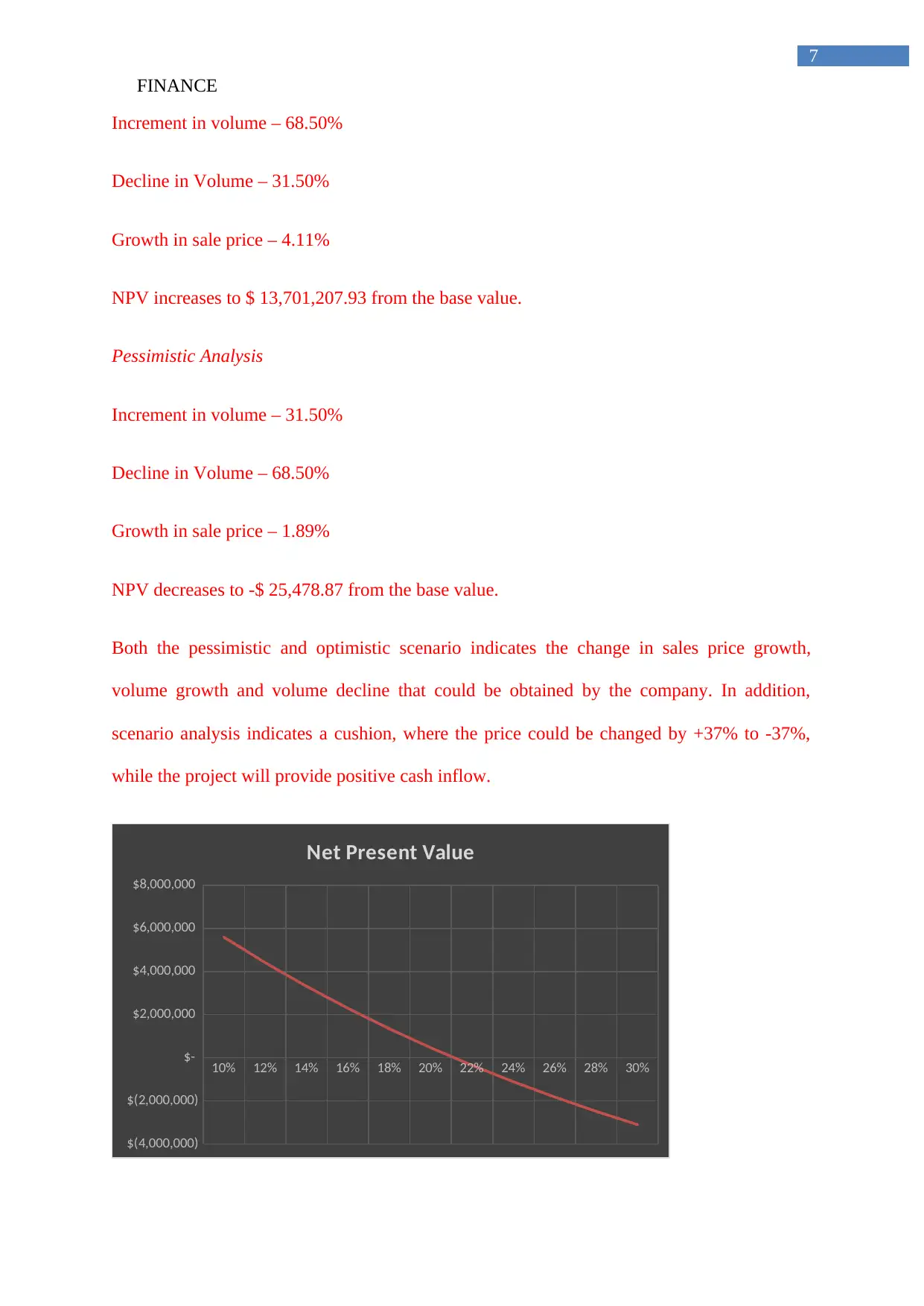
FINANCE
7
Increment in volume – 68.50%
Decline in Volume – 31.50%
Growth in sale price – 4.11%
NPV increases to $ 13,701,207.93 from the base value.
Pessimistic Analysis
Increment in volume – 31.50%
Decline in Volume – 68.50%
Growth in sale price – 1.89%
NPV decreases to -$ 25,478.87 from the base value.
Both the pessimistic and optimistic scenario indicates the change in sales price growth,
volume growth and volume decline that could be obtained by the company. In addition,
scenario analysis indicates a cushion, where the price could be changed by +37% to -37%,
while the project will provide positive cash inflow.
10% 12% 14% 16% 18% 20% 22% 24% 26% 28% 30%
$(4,000,000)
$(2,000,000)
$-
$2,000,000
$4,000,000
$6,000,000
$8,000,000
Net Present Value
7
Increment in volume – 68.50%
Decline in Volume – 31.50%
Growth in sale price – 4.11%
NPV increases to $ 13,701,207.93 from the base value.
Pessimistic Analysis
Increment in volume – 31.50%
Decline in Volume – 68.50%
Growth in sale price – 1.89%
NPV decreases to -$ 25,478.87 from the base value.
Both the pessimistic and optimistic scenario indicates the change in sales price growth,
volume growth and volume decline that could be obtained by the company. In addition,
scenario analysis indicates a cushion, where the price could be changed by +37% to -37%,
while the project will provide positive cash inflow.
10% 12% 14% 16% 18% 20% 22% 24% 26% 28% 30%
$(4,000,000)
$(2,000,000)
$-
$2,000,000
$4,000,000
$6,000,000
$8,000,000
Net Present Value
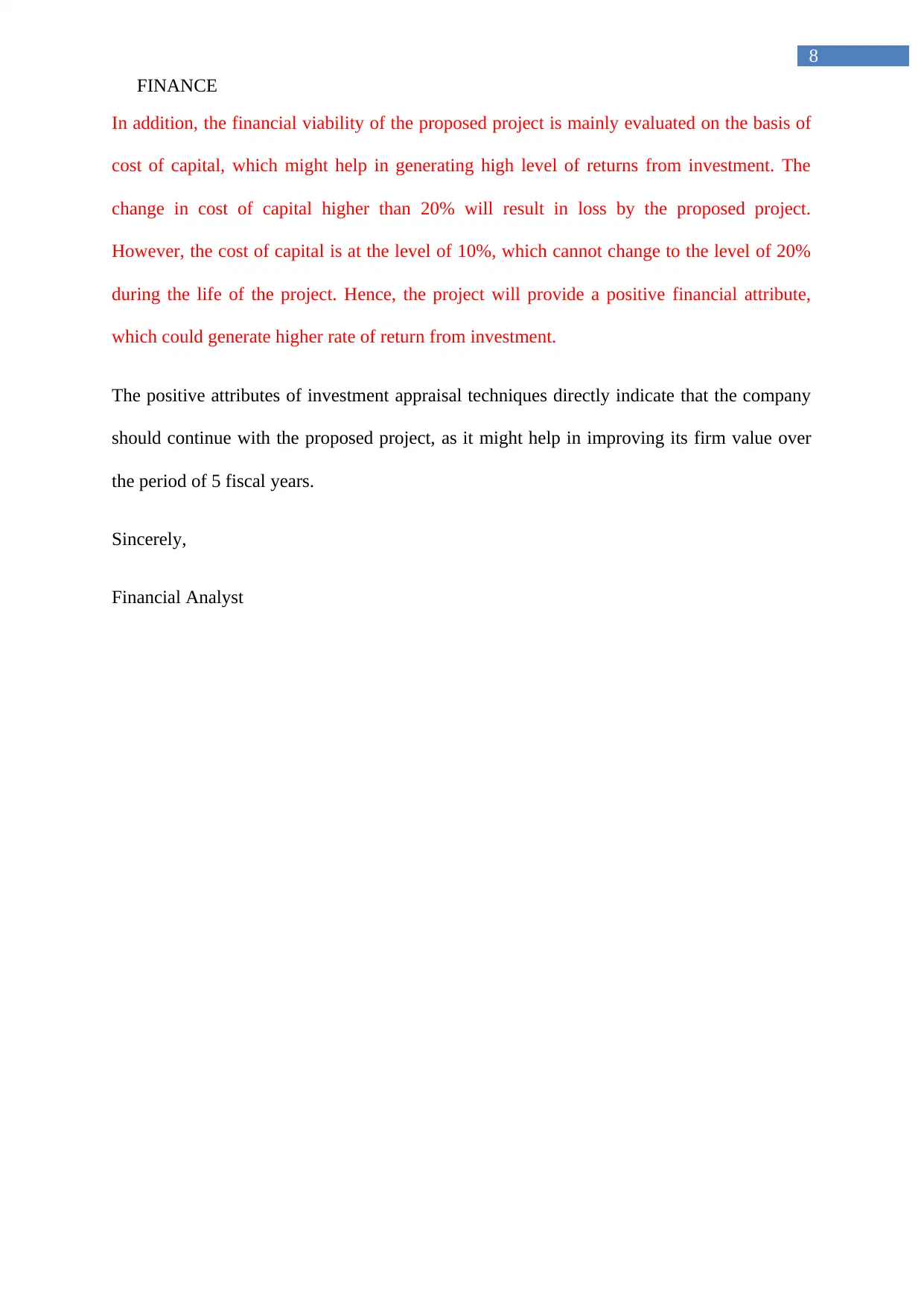
FINANCE
8
In addition, the financial viability of the proposed project is mainly evaluated on the basis of
cost of capital, which might help in generating high level of returns from investment. The
change in cost of capital higher than 20% will result in loss by the proposed project.
However, the cost of capital is at the level of 10%, which cannot change to the level of 20%
during the life of the project. Hence, the project will provide a positive financial attribute,
which could generate higher rate of return from investment.
The positive attributes of investment appraisal techniques directly indicate that the company
should continue with the proposed project, as it might help in improving its firm value over
the period of 5 fiscal years.
Sincerely,
Financial Analyst
8
In addition, the financial viability of the proposed project is mainly evaluated on the basis of
cost of capital, which might help in generating high level of returns from investment. The
change in cost of capital higher than 20% will result in loss by the proposed project.
However, the cost of capital is at the level of 10%, which cannot change to the level of 20%
during the life of the project. Hence, the project will provide a positive financial attribute,
which could generate higher rate of return from investment.
The positive attributes of investment appraisal techniques directly indicate that the company
should continue with the proposed project, as it might help in improving its firm value over
the period of 5 fiscal years.
Sincerely,
Financial Analyst
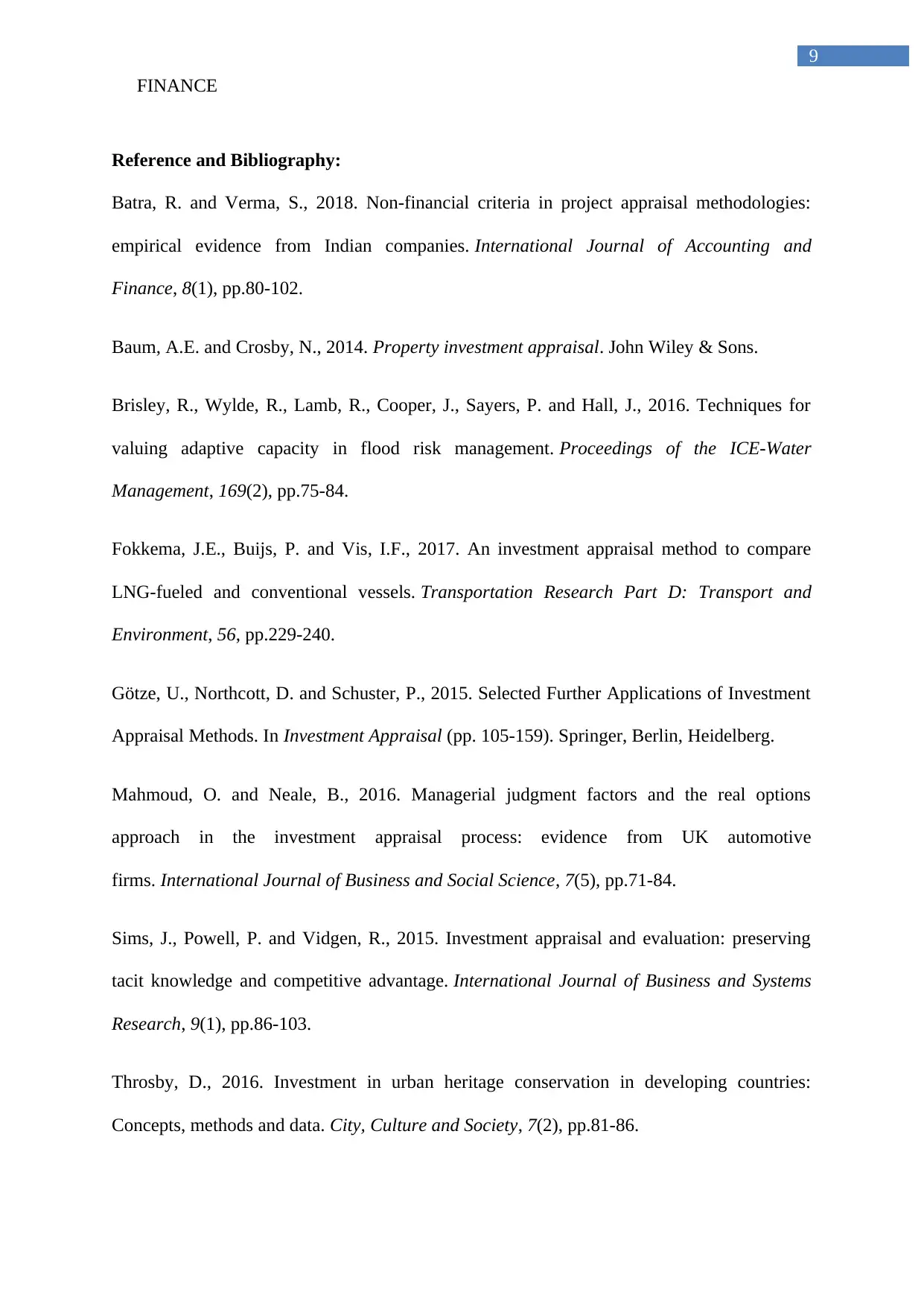
FINANCE
9
Reference and Bibliography:
Batra, R. and Verma, S., 2018. Non-financial criteria in project appraisal methodologies:
empirical evidence from Indian companies. International Journal of Accounting and
Finance, 8(1), pp.80-102.
Baum, A.E. and Crosby, N., 2014. Property investment appraisal. John Wiley & Sons.
Brisley, R., Wylde, R., Lamb, R., Cooper, J., Sayers, P. and Hall, J., 2016. Techniques for
valuing adaptive capacity in flood risk management. Proceedings of the ICE-Water
Management, 169(2), pp.75-84.
Fokkema, J.E., Buijs, P. and Vis, I.F., 2017. An investment appraisal method to compare
LNG-fueled and conventional vessels. Transportation Research Part D: Transport and
Environment, 56, pp.229-240.
Götze, U., Northcott, D. and Schuster, P., 2015. Selected Further Applications of Investment
Appraisal Methods. In Investment Appraisal (pp. 105-159). Springer, Berlin, Heidelberg.
Mahmoud, O. and Neale, B., 2016. Managerial judgment factors and the real options
approach in the investment appraisal process: evidence from UK automotive
firms. International Journal of Business and Social Science, 7(5), pp.71-84.
Sims, J., Powell, P. and Vidgen, R., 2015. Investment appraisal and evaluation: preserving
tacit knowledge and competitive advantage. International Journal of Business and Systems
Research, 9(1), pp.86-103.
Throsby, D., 2016. Investment in urban heritage conservation in developing countries:
Concepts, methods and data. City, Culture and Society, 7(2), pp.81-86.
9
Reference and Bibliography:
Batra, R. and Verma, S., 2018. Non-financial criteria in project appraisal methodologies:
empirical evidence from Indian companies. International Journal of Accounting and
Finance, 8(1), pp.80-102.
Baum, A.E. and Crosby, N., 2014. Property investment appraisal. John Wiley & Sons.
Brisley, R., Wylde, R., Lamb, R., Cooper, J., Sayers, P. and Hall, J., 2016. Techniques for
valuing adaptive capacity in flood risk management. Proceedings of the ICE-Water
Management, 169(2), pp.75-84.
Fokkema, J.E., Buijs, P. and Vis, I.F., 2017. An investment appraisal method to compare
LNG-fueled and conventional vessels. Transportation Research Part D: Transport and
Environment, 56, pp.229-240.
Götze, U., Northcott, D. and Schuster, P., 2015. Selected Further Applications of Investment
Appraisal Methods. In Investment Appraisal (pp. 105-159). Springer, Berlin, Heidelberg.
Mahmoud, O. and Neale, B., 2016. Managerial judgment factors and the real options
approach in the investment appraisal process: evidence from UK automotive
firms. International Journal of Business and Social Science, 7(5), pp.71-84.
Sims, J., Powell, P. and Vidgen, R., 2015. Investment appraisal and evaluation: preserving
tacit knowledge and competitive advantage. International Journal of Business and Systems
Research, 9(1), pp.86-103.
Throsby, D., 2016. Investment in urban heritage conservation in developing countries:
Concepts, methods and data. City, Culture and Society, 7(2), pp.81-86.
1 out of 10
Related Documents
Your All-in-One AI-Powered Toolkit for Academic Success.
+13062052269
info@desklib.com
Available 24*7 on WhatsApp / Email
![[object Object]](/_next/static/media/star-bottom.7253800d.svg)
Unlock your academic potential
© 2024 | Zucol Services PVT LTD | All rights reserved.





